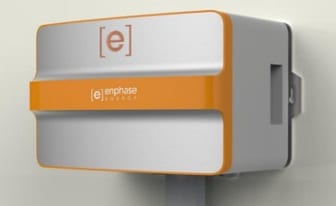US-based solar technology giant Enphase Energy has chosen Australia for the launch of its AC battery unit, the micro-inverter specialist’s first commercial offering to the global energy storage market.
The battery, which we previewed here in December 2014, is a 1.2kWh compact modular plug-and-play energy storage system which, when used with the company’s cloud-based Enphase Energy Management System, allows consumers to store and manage their rooftop solar energy supply and control their overall household energy use on a single platform.

Nathan Dunn, managing director for Enphase Asia-Pacific, announced on Wednesday at RenewEconomy’s Disruption & The Energy Industry Conference in Sydney, that the company would rollout their battery first in Australia and said he expected it to be commercially available in Australia in 2016.
“Australia has always been a strategic market for Enphase,” Dunn said at the release. “In the last two years since we’ve established a direct presence here, we’ve continued to see strong growth and demand for our microinverter systems.
“Enphase sees tremendous potential for the AC Battery in Australia and we are delighted to be the first country in the world to be introducing the Enphase AC Battery commercially.”
Since 2013, Enphase has been rapidly deploying its microinverter systems Australia-wide to become the dominant microinverter technology in the region, mostly on residential rooftop solar installations, as homeowners turn to solar to help reduce their energy bills.
And in March, it announced its first strategic partnership in Australia, signing up with EnergyAustralia, one of the big three retailers in the country, to market its micro-inverter technology.
Last year, when asked about the appeal of the Australian market, Enphase CEO Paul Nahi put it down to a “bunch of things,” including the right insolation, GDP growth, advanced solar market and political stability (although he also stressed favourable renewables policy was not a prerequisite.)
He has also predicted Australia would be one of the first markets in the world to reach “parity” for battery storage products.

“Our goal is to provide the technology to enable mass adoption of solar,” Nahi told RenewEconomy in an interview in December.
“The US is still years behind Australia, which in a way, represents an opportunity for us, because we can create products and services that an evolving, a burgeoning solar market really needs and can leverage. Storage is a perfect example of that. (It’s) really one element of the energy management system.”
According to Nahi, the global energy future lies in efficient, high-tech energy management.
“Enphase is… a high technology company in the solar space,” said Nahi. “Our view, say, two to three years out; we actually don’t believe that people will sell a solar system, or buy a solar system, we believe that you are going to buy an energy system.
“That will necessarily include solar, but it will also include storage, it will also include load management, and it will be wrapped up in a software package and a financial package,” he said.
“We don’t want to take everybody off grid. What we do want to do is to provide the consumer the ability to manage and create their own energy; to do it in an affordable way, to do it very simply.
“(We want to) work with the utilities, to help them embrace solar, and recognise that in some cases, business models will need to change.”
“The fact that we have consistent and affordable energy is powerful. We don’t want to mess with that,” he said.
“At the same time, we know that if we stay the course, we’re in very big trouble. Both individually, because the cost of energy is going to continue to go up – and by the way it will go up even if you don’t include the price of carbon. I can almost guarantee that carbon will be priced, in different countries and at different rates, but it is absolutely coming.”
ELIIY Power, a leading Japanese battery manufacturer backed by Daiwa House, Japan’s largest homebuilder, will be the chemistry provider for the first Enphase AC batteries when they are released in Australia.
All existing customers in Australia will be given the opportunity to register their interest in the Enphase AC Battery ahead of general availability.










